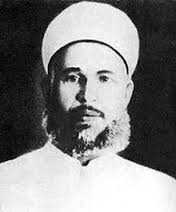Pages in Section 5

The Black Hand and Inspector Salim Basta
ii.Dowbiggin's Report
iii. Re-organization of the Palestine Police
iv. The Black Hand
v. The 1933 Riots
vi. The Arlosorrof Case and Creation of the Dog Section
vii. King George V's Silver Jubilee
viii. The Black Hand re-emerges
 Izza al-kader Mustafa Yusuf ad-Din al-Qassam had already taken part in military style resistance in Libya and supported Prince Faisal against the French in Syria before moving to Palestine in 1920.
Izza al-kader Mustafa Yusuf ad-Din al-Qassam had already taken part in military style resistance in Libya and supported Prince Faisal against the French in Syria before moving to Palestine in 1920.
In contrast to traditional Palestinian leaders, notables who campaigned against Zionist settlement while avoiding confrontation with the British authorities, al- Qassam, leader of the Black Hand, advocated a moral, political and military Jihad to end British rule and Zionist occupation. His charisma, his patriotism, his preaching and his devotion to Arab down-and-outs made him the most influential and loved man amongst the low-paid Arab workers of Haifa. He not only cared for his followers physical and spiritual welfare but he waged war on illiteracy and ignorance.
From 1929, when, he became marriage registrar for the Sharia court in northern Palestine, Izz ad-Din al-Qassam extended his influence to the northern villages, where he encouraged the fellaheen to set up agricultural cooperatives. He also delivered fiery sermons in the local mosques promoting a revolution that would have national, political, spiritual and economic dimensions . He urged his followers to create guerrilla bands to attack the British and Jews. The guerrilla bands became known as the Black Hand. At night al-Qassam trained his men to use firearms in the quarries on the slopes of Mt Carmel and taught them how to make bombs. He urged his men to be patient and wait until they had a large enough army before making their first move against their enemy but his men were impatient. One evening in April 1931, while the police service were still awaiting the arrival of their new Inspector General Spicer, one of al-Qassam's bands ambushed and killed three members of Kibbutz Yagur as they were returning home on a hay cart. In January 1932 they shot a Jewish farmer at his front door but a bomb attack on outlying Jewish homes in Haifa failed. In March they killed another farmer and during Hanukkah 1932 in the moshav Nahalal in the Jezreel Valley, they murdered a farmer and wounded his eight year old son by throwing a bomb into their house.
By this time the new head of CID, Harold Rice had re-organised his department. Rice set up his HQ inside Nahalal and directed his whole Haifa team to concentrate on this one incident. The forensic services, photographic department and Jerusalem's Criminal Records Department were used to the full. Inspector Salim Basta, an Egyptian Copt who had the reputation of being the best investigator ever, was a member of this team.
The man who threw the bomb was traced to an Arab village which overlooked Nahalal.
Salim Basta investigated the connection between the man who had thrown the bomb and the owners of a gramophone repair shop.,He found enough evidence in the way of particles of lead and other metals in the shop to connect them to the bomb. Because of this connection the police discovered the existence of the Black Hand and its leader.
Once the police knew about their existence and started arresting their members, the clandestine cells took to the hills of Galilee where they lay low for two years .